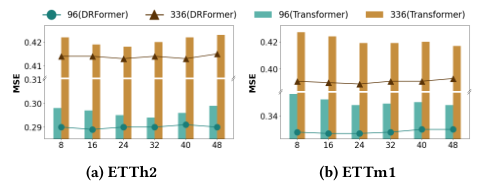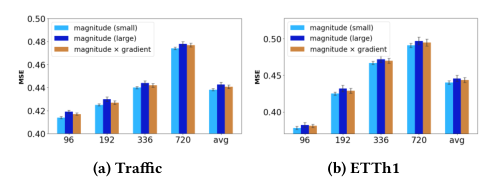DRFormer: Multi-Scale Transformer Utilizing Diverse Receptive Fields for Long Time-Series Forecasting
Ruixin Ding, Yuqi Chen, Yu-Ting Lan, Wei Zhang·August 05, 2024
Summary
DRFormer, introduced at CIKM '24, is a novel dynamic patching strategy combined with a group-aware Roformer network for long-term time series forecasting. It utilizes a dynamic tokenizer with a dynamic sparse learning algorithm to capture diverse receptive fields and sparse patterns in time series data. The multi-scale Transformer model incorporates multi-scale sequence extraction to capture multi-resolution features, while a group-aware rotary position encoding technique enhances intra- and inter-group position awareness across different temporal scales. Experimental results on various real-world datasets demonstrate DRFormer's superiority compared to existing methods.
The paper also discusses related work, including transformer-based models, CNNs for time-series forecasting, and relative position embedding techniques. DRFormer excels in univariate time series forecasting, outperforming competitors like Koopa, PatchTST, TimesNet, FEDformer, ETSformer, Autoformer, Informer, and Reformer. It achieves the best or second-best performance across different datasets, with the input length set to 96 for each dataset. The prediction lengths vary for different datasets, ranging from 24 to 720.
In an ablation study on the Traffic dataset, DRFormer's performance is analyzed with and without multi-scale features (MS), dynamic tokenizer (DT), and RoPE (relative position encoding). The results show that incorporating these features improves forecasting accuracy, with the best performance achieved when all components are utilized. The model's implementation details include using PyTorch for coding, with a hidden dimension size of 128 for ETT datasets and 512 for others. The patch length and stride are set to 16 and 4 for ECL, Traffic, and ETT datasets, and 24 and 2 for the ILI dataset. Dynamic linear parameters are configured with 8 groups and a sparse ratio of 0.5. The update frequency is set to 30% of the iterations per epoch, and the multi-scale transformer uses 3 multi-view sequences with specific stride values.
DRFormer surpasses state-of-the-art methods in multivariate forecasting, achieving significant reductions in Mean Squared Error (MSE) and Mean Absolute Error (MAE) across various datasets. On average, it reduces MSE by 6.20% compared to the best baselines. The paper also discusses various research papers and articles related to time-series forecasting and large language models, highlighting advancements in the field.
In conclusion, DRFormer is a significant contribution to the field of long-term time series forecasting, offering improvements in capturing diverse characteristics across various scales and demonstrating superior performance compared to existing methods. Its dynamic patching strategy, group-aware Roformer network, and multi-scale Transformer model make it a powerful tool for forecasting tasks, with potential applications in various domains such as finance, healthcare, and traffic prediction.
Introduction
Background
Overview of time series forecasting
Importance of long-term forecasting in various domains
Challenges in long-term time series forecasting
Objective
Aim of the research
Contribution of DRFormer to the field of time series forecasting
Method
Dynamic Patching Strategy
Explanation of dynamic patching
Integration with Roformer network
Data Preprocessing
Dynamic tokenizer with dynamic sparse learning algorithm
Capturing diverse receptive fields and sparse patterns
Multi-scale Transformer Model
Multi-scale sequence extraction for multi-resolution features
Group-aware rotary position encoding for enhanced position awareness
Related Work
Transformer-based Models
Overview of transformer models in time series forecasting
Comparison with DRFormer
CNNs for Time-series Forecasting
Comparison with convolutional neural networks
Advantages and limitations
Relative Position Embedding Techniques
Comparison with DRFormer's RoPE technique
Enhancements in intra- and inter-group position awareness
Experimental Results
Performance Comparison
DRFormer's superiority over existing methods
Results on various real-world datasets
Ablation Study
Analysis of DRFormer's components
Impact of multi-scale features, dynamic tokenizer, and RoPE
Implementation Details
Coding and Libraries
Use of PyTorch for implementation
Hidden dimension sizes for different datasets
Model Parameters
Patch length, stride, and dynamic linear parameters
Update frequency and multi-scale transformer configuration
Multivariate Forecasting
Performance Metrics
Mean Squared Error (MSE) and Mean Absolute Error (MAE)
Reduction in error compared to state-of-the-art methods
Research and Articles
Time-series Forecasting
Overview of related research papers
Contributions to the field
Large Language Models
Discussion on advancements in large language models
Relevance to time series forecasting
Conclusion
Summary of Contributions
Recap of DRFormer's features and benefits
Future Work
Potential areas for further research
Applications in various domains
Impact
Significance of DRFormer in the field of time series forecasting
Basic info
papers
machine learning
artificial intelligence
Advanced features
Insights
How does DRFormer utilize a dynamic tokenizer and dynamic sparse learning algorithm to capture diverse receptive fields and sparse patterns in time series data?
What is DRFormer and how does it improve long-term time series forecasting?
How does the group-aware rotary position encoding technique in DRFormer enhance intra- and inter-group position awareness across different temporal scales?







